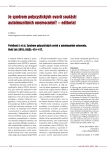The progress of autonomic parameters in patients after myocardial infarction with ST elevation
Authors:
P. Lokaj 1; J. Pařenica 1; P. Kala 1; N. Honzíková 2; R. Lábrová 1; J. Špinar 1
Authors‘ workplace:
Interní kardiologická klinika Lékařské fakulty MU a FN Brno, pracoviště Bohunice, přednosta prof. MU Dr. Jindřich Špinar, CSc., FESC
1; Fyziologický ústav Lékařské fakulty MU Brno, přednostka prof. MU Dr. Nataša Honzíková, CSc.
2
Published in:
Vnitř Lék 2010; 56(5): 392-396
Category:
Original Contributions
Overview
The patients after myocardial infarction with ST elevation (STEMI) are endangered by the development inception of autonomic dysfunction, decreased baroreflex sensitivity, decreased heart rate variability, and increased blood pressure variability as a result of increased sympathetic activity and/ or decreased parasympathetic activity. Thanks to direct angioplasty and optimal pharmacotherapy of coronary artery disease and heart failure, we didn’t found any significant changes of these parameters within a one‑year follow‑up, and mortality due to cardiac etiology was very low in this group. Autonomic dysfunction and negative left ventricular remodeling is related only to a small group of patients after STEMI, whose risk stratification will be difficult.
Key words:
myocardial infarction with ST elevation – baroreflex sensitivity – autonomic dysfunction
Sources
1. Kala P, Poloczek M, Výtiska M et al. Remodelace levé komory po STEMI přední stěny a její vztah k akutním změnám v průběhu primární PCI. Interv Akut Kardiol 2007; 6: 92– 96.
2. La Rovere MT, Specchia G, Mortara A et al. Baroreflex sensitivity, clinical correlates and cardiovascular mortality among patients with first myocardial infarction. Circulation 1998; 78: 816– 824.
3. La Rovere MT, Digger JT Jr, Marcus FI et al. Baroreflex sensitivity and heart‑ rate variability in prediction of total cardiac mortality after myocardial infarction. ATRAMI (Autonomic Tone and Reflexes After Myocardial Infarction) investigators. Lancet 1998; 351: 478– 484.
4. Honzíková N, Semrád B, Fišer B et al. Risk stratification after myocardial infarction. Scripta Medica 1997; 70: 153– 158.
5. Honzíková N, Semrád B, Fišer B et al. Baroreflex sensitivity determined by spectral method and heart rate variability, and two‑years mortality in patients after myocardial infarction. Physiol Res 2000; 49: 643– 650.
6. Semrád B, Fišer B, Honzíková N. Baroreflex sensitivity: Do We Have Any Progress? Card Electrophysiol Rev 1999; 3: 290– 293.
7. Zijlstra F, Patel A, Jones M et al. Clinical characteristics and outcome of patients with early (< 2 h), intermediate (2–4 h) and late (> 4 h) presentation treated by primary coronary angioplasty or thrombolytic therapy for acute myocardial infarction. Eur Heart J 2002; 23: 550– 557.
8. Brodie BR, Stuckey TD, Wall TC et al. Importance of time to reperfusion for 30- day and late survival and recovery of left ventricular function after primary angioplasty for acute myocardial infarction. J Am Coll Cardiol 1998; 32: 1312– 1319.
9. Lantelme P, Cerutti C, Lo M et al. Mechanism of spontaneous baroreflex impairment in Lyon hypertensive rats. Am J Physiol 1998; 275: R920– R925.
10. La Rovere MT, Mortara A, Specchia Get al. Myocardial infarction and baroreflex sensitivity. G Ital Cardiol 1992; 22: 639– 645.
Labels
Diabetology Endocrinology Internal medicineArticle was published in
Internal Medicine

2010 Issue 5
Most read in this issue
- Familial hypercalcemia and hypophosphatemia: importance in differential diagnosis of disorders in calcium‑ phosphate metabolism
- A review of the effects of prolactin hormone and cytokine on the development and pathogenesis of autoimmune diseases
- Polycystic ovary syndrome and autoimmune diseases
- ILCOR recommendation on signing of automated external defibrillators (AEDs)
